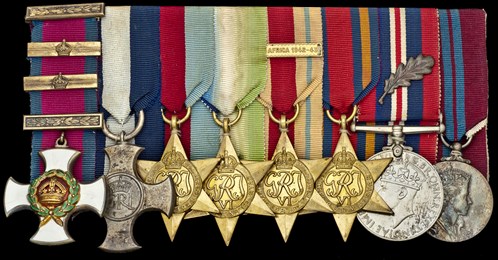A Naval Hero's Medals Up For Auction

A sale full of extremely interesting items from around the world and some exquisite collections. But one lot in particular stands out amidst this sale, lot 7; the Outstanding Second War D.S.O. and Two Bars, D.S.C. Group of Eight to Captain E.N. 'Won't-Go-Home' Pumphrey, Royal Navy. A pioneering skipper of motor torpedo boats who was one of the Royal Navy's most successful coastal force Captains of the Second World War, he distinguished himself in the 'Spitfires of the Seas' during the first great M.T.B. action of the War; during a daring daylight attack on theScharnhorstandGneisenau; and as Commander of H.M.S.Brocklesbyfor the Dieppe Raid.
Captain Edward Nigel Pumphrey, D.S.O., D.S.C., was born in Ryton-on-Tyne in 1910. After service as a Naval Cadet in H.M.SNelsonandResolution, he was Commissioned Sub-Lieutenant, 16.5.1931, and promoted Lieutenant, 16.95.1933. His career was highlighted by amazing feats of naval tenacity. Spink are lucky enough to possess the materials that even allow Pumphrey to tell his version of the attack on the German battle cruisers:ScharnhorstandGneisenau, with the heavy cruiserPrinzEugen, when they passed through the Straits of Dover on their way from Brest to Germany on the 12th February 1942.
Pumphrey was sitting in his office doing some paper-work when, at 11:35am, the telephone rang. "Pumphrey", said the voice, "The Battle Cruisers are off Boulogne now. How soon can you get cracking?" Pumphrey's own account of the action is as follows:
There was a mad rush down to the boats, and we got the M.T.B.s started like lightening . . . There wasn't a second to be wasted if we were to make an interception of 27-knot ships with 24-knot M.T.B.s.
Manning the boats was a terrific scene.ScharnhorstandGneisenauhad become almost a myth at Dover, and here we were in broad daylight setting off after them. It didn't seem possible. Even apart fromScharnhorstandGneisenau, to do a M.T.B. operation at noon seemed almost indecent. I shall never forget the chaps grinning all over their faces as we formed up and screamed out at 24 knots. At 12:10pm we saw fighters, masses of them, all Messerschmitts. A squadron flew over us very close, and we all blazed away at them. Simultaneously we sighted smoke in two distinct patches to the south-east, and almost immediately we saw the E-boats who were laying it- ten of them in two divisions half a mile apart. Course was altered to converge on the E-boats. When the range was down to 1,000 yards both sides started shooting, but at that range in a moderate sea it was almost a waste of ammunition. Then the main enemy force came clear of the smoke- three great ships with destroyers stationed astern of them. They were on the same course as the E-boats, but 4,000 yards further away. I noticed that their guns were all trained fore and aft, their speed at 27 knots. The situation was an impossible one. The E-boats barred the path of an M.T.B. attack, and though I ordered emergency full speed ahead in an attempt to draw ahead of them, I felt pretty sure it would be useless. I was right. The E-boats merely put on another knot or two, maintaining their excellent defensive position.
There were two alternatives- either to try and battle through the E-boats, or to accept firing at long range. The M.T.B.s were on the ideal bearing, but the range was hopelessly long. I altered course to try to fight through the screen. It was a mad thing to do - the inevitable result would have been the loss of all E-boats before the range could have been reduced to a reasonable one. But chance took a hand, and, as I turned, my starboard engine conked and my speed fell back to 16 knots. In these circumstances there was only one thing to do - to hold on until the E-boat fire became a serious danger, and then to fire at a range of 4,000-odd yards. We steered in, in line abreast, until the E-boats' range was 200 yards. Even then they scarcely touched us - it was too rough for shooting. We fired our torpedoes carefully, but without much hope, and turned away. The whole operation had been most unsatisfactory. About three minutes after firing,ScharnhorstandGneisenauturned 90 degrees away and our last hope of a lucky hit evaporated." (The Battle of the Narrow Seas, by Sir Peter Scott refers).
For his 'fine leadership, courage, and resolution', Pumphrey was awarded the Distinguished Service Order, as much for this action as for his sterling work in the many other battles he had fought. Captain Nigel Pumphrey retired from the Royal Navy, 01.07.1956, after more than 32 years' service, and moved to Greatham in Hampshire. Modest to the last, in a letter to his grandson shortly before his death he wrote: 'Many others did much more in the War than I did, for much less recognition. I was lucky to get all those gongs.' He died, 29.09.1994. Only 21 Naval Officers received a D.S.O. and Two Bars during the Second World War.
 |
Lot 7, £25,000 - 30,000
For more information, please contact Oliver Pepys:
Tel: +44 (0)20 7563 4061 | Email: [email protected]
About Spink
Spink is the world's leading auctioneer of stamps, coins, banknotes, medals, bonds & shares, autographs, books and wine. Since its foundation in 1666, the Spink name has become synonymous with tradition, experience and integrity. Holder of royal warrants and numerous records for prices achieved at auction, Spink offers an unparalleled range of services to collectors worldwide. Headquartered in London, with offices in New York, Hong Kong, Singapore and Switzerland, Spink holds over 70 auctions a year. Catalogues can be accessed through the Spink website (www.spink.com) or via the Spink App for iPhone and iPad.



